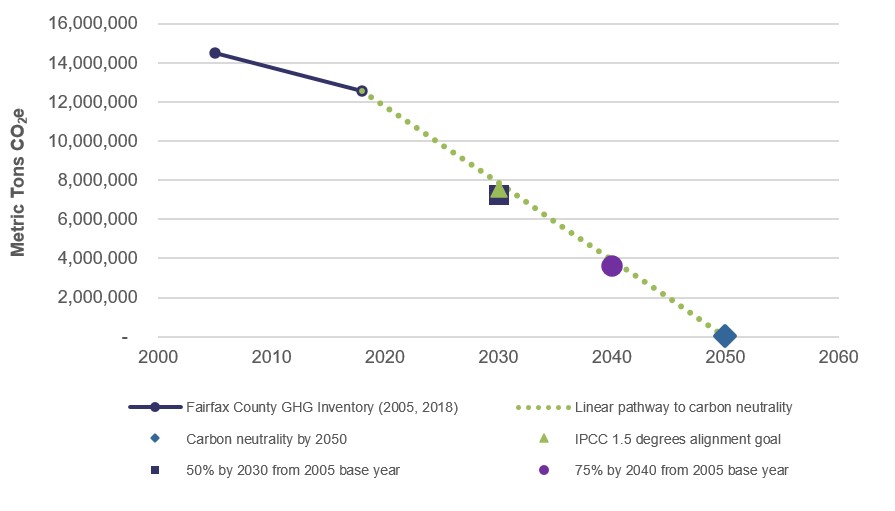Carbon Neutrality by 2050
The overarching, long-term target goal of CECAP is for the Fairfax County community to achieve carbon neutrality by 2050, with 87 percent of the necessary emission reductions coming from local sources and actions, as opposed to the purchase of carbon offsets.
For the purposes of CECAP, carbon neutrality means achieving net zero emissions by balancing greenhouse gases released in our community with an equivalent amount reduced or offset using carbon credits.
Interim Target Year Goals
On the way to realizing carbon neutrality, the CECAP Working Group set two interim target year goals for the community:
- Fairfax County will reduce greenhouse gas emissions by 50 percent by 2030.
- Fairfax County will reduce greenhouse gas emissions by 75 percent by 2040.
The interim goals are all about keeping us on track and helping the community to benchmark our progress on the way to carbon neutrality by 2050. The 2030 interim goal aligns with the Intergovernmental Panel on Climate Change's (IPCC) findings regarding the importance of keeping global temperature increases below 1.5 degrees Celsius.
The 2040 interim goal aligns with our 2050 carbon neutrality goal. All three of the target year goals are illustrated in the graph below, which is also available on page 28 of the final CECAP report.

Sector-Specific Goals
In addition to target year goals, the Working Group selected a series of sector-specific goals to further guide the actions of the community as we work toward carbon neutrality. The goals are listed below.
- All new, eligible buildings in the county will have a commitment to green building.
- Retrofit at least 100,000 housing units with energy efficiency measures by 2030.
- Increase transit and non-motorized commuting to 30 percent (including teleworking) by 2030.
- Increase plug-in electric hybrid vehicles and battery electric vehicles to at least 15 percent of all light-duty vehicle registrations by 2030.
- Expand the tree canopy to 60 percent with a minimum of 40 percent tree canopy coverage in every census block by 2030 and a minimum of 50 percent tree canopy coverage in every census block by 2050, prioritizing areas of highest socioeconomic need first.
- Achieve zero waste by 2040, defined as at least 90 percent waste diverted from landfill/incineration, in alignment with the definition by the Zero Waste International Alliance.
Each of the sector-specific goals addresses an area where we can make a real impact on our local greenhouse gas emissions. The two top sources of greenhouse gases in Fairfax County are energy use in buildings, both residential and commercial (49 percent of all emissions), and transportation, like cars and trucks on our roads (44 percent of all emissions). It's no wonder four of the six sector-specific goals relate to these two areas of focus.

